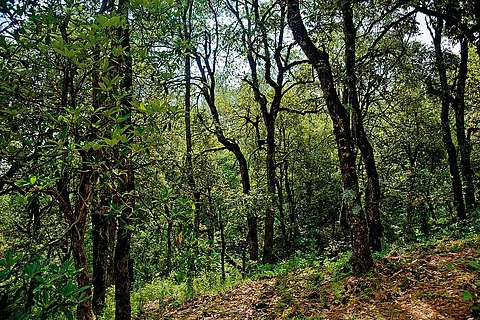
- Destinations
- Experiences
- Stay
- What's new
- Celebrating People
- Responsible Tourism
- CampaignsCampaigns
- SubscribeSubscribe
- Buy Now

One afternoon, I noticed smoke from our camp. My mother and I rushed to control the fire. Two years later, it happened again, right next to our property. My husband and I, and our staff, fought the fire until 1 am,” says Tanuja Sah, pointing towards the dense patch of green where it all happened, as we walk through the forest. On our way, she points at the burnt leaves and shows me what were once tall tree trunks, now charred and razed to the ground.
“When we moved here to open our boutique stay, Nayalap, we did not know about the forest teams and the WhatsApp action group, Jungle Ke Dost, that is used to report fires and mobilise the local community for help,” she says. This group, which Sah and 800 others now belong to, was started by Gajendra Pathak, also a guesthouse owner and pharmacist in Shitlakhet, Uttarakhand.
While the social media app formally became a forum for reporting fire breakouts in 2020, the group has been active for two decades. Its origin dates to 2004, when the Kosi River, which supplies water to Almora, dried up in the summer months. This disrupted the water supply to the town, and the springs also dried up, urging Pathak to take matters into his own hands.
“The springs used to be full enough to bathe in during summer—seeing them dry was deeply disturbing. At the time, we were young, but we observed the environmental changes—dense forests of banj (oak), buransh (rhododendron), and kafal (bayberry) had been replaced by chir pine. We realised that deforestation and forest fires were the reasons behind the drying up of water sources.”
While Uttarakhand's CM Pushkar Singh Dhami applauded this community-driven approach to forest fire management, recognising and promoting it officially as the “Shitlakhet Model” in 2022, the initial days were not straightforward.
Pathak recounts, “There was resistance. When we spoke to people from the surrounding villages, requesting them not to cut the broadleaf trees, they questioned why we were stopping them when they had been doing this for years. But when we explained that it’s essential for our shared future and that the water crisis would worsen, people gradually began to understand.”
Since then, the number of members has grown significantly, with nearly 400 women joining the force and playing a crucial role as first responders. “Due to migration and lack of employment, only a few men live in these villages now, so women are the main workforce. They also know the forest more intimately as they take their cattle for grazing or go to collect wood. They are the primary contributors and backbone of this movement.
Currently, the group works across 7,000 hectares, covering around 40 villages. Their role is two-fold. "If someone spots smoke, they send a message in the WhatsApp group. This works on the "golden hour" concept. Like in medical science, where the first hour after an accident is crucial, similarly, if we act quickly when a fire starts, we can control it. The first responder may be someone from that village or a nearby one. As soon as we receive the information, we notify the forest department. Since their team often takes an hour or two to arrive, we ask local villagers in the Jungle Ke Dost network to act fast. In many cases, the villagers have already extinguished a fire by the time the first officials arrive,” Pathak explained.
In addition to fighting forest fires with immediate effect, the community’s priority is prevention. “Due to the lack of winter rain and snowfall, drought-like conditions have developed in the hilly regions of Uttarakhand. Forest fires only worsen the situation by destroying biomass, which nature takes years to accumulate, in just minutes. And unfortunately, most of these forest fires don’t start on their own—they are usually triggered by carelessness while burning crop residue or by carelessly discarding matchsticks after lighting a cigarette,” said Pathak.
As a solution, villagers are encouraged to clear fields by the end of March, before the summer months begin. Some are also involved in creating fire lines to combat crown fire, which spreads through the upper canopy of trees.
“To tackle surface fires, we typically use kafal (bayberry) tree branches, beating the flames until they subside. However, this method isn’t always effective. That’s why we also use a technique known as counterfire or crossfire. This method intentionally burns specific zones during January–February, creating fire lines about 20–40 ft wide. This removes dry biomass, which is susceptible to catching fire.”
While Jungle ke Dost has protected nearly 500 hectares of forest land, challenges persist. However, Pathak and his team’s passion to protect their land is much stronger. “Forces of good and evil have always coexisted. Even today, some people try to cause trouble by deliberately starting forest fires or discouraging women from participating. But despite that, Jungle ke Dost has achieved something powerful—it has instilled a sense of ownership among the people. Jungle hamare hain, humein hi bachane hain.”
